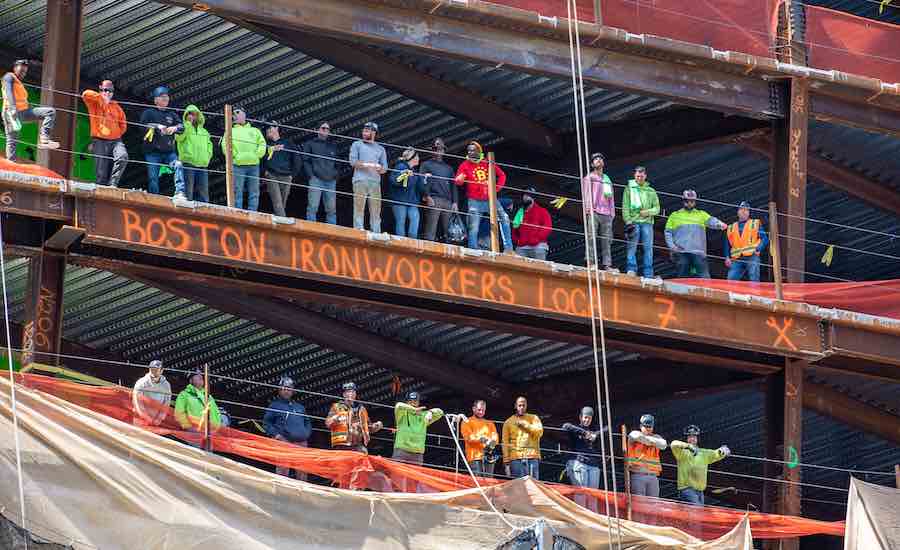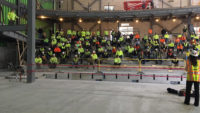After Shawn Nehiley injured his back on the job in 2002 while working as a journeyman for Iron Workers Local 7, he was prescribed opioids for pain. “When they gave me the oxycontin, I felt like Superman, but that turned real quick,” he recalls.
Speaking during an April 28 stand-down in Boston’s Seaport that concluded the third annual Building Trades Recovery Week, the president of the Ironworkers District Council of New England was one of several speakers who shared their story of addiction and recovery with approximately 500 workers. The Building Trades Employers’ Association Northeast organized the event along with Turner Construction Co., Suffolk Construction and WS Development.
The stand-down, which takes place during National Recovery Month, seeks to enjoin the unionized construction industry to fight substance use disorder, and help find ways to improve mental health and break through stigmas associated with these conditions.
Additional stand-downs were held the same day by the New England Laborers’ Health and Safety Fund involving some 100 workers from Dimeo Construction and Shawmut Construction in Providence, R.I. Both events included a 60-second moment of silence to commemorate the 229 construction workers out of every 100,000 who die from substance use disorders each year.
Fighting Back
An alcoholic, Nehily had been sober for 16 years when he sustained his back injury in 2002 and was prescribed opioids.
"My life was good, I had gotten into the Ironworkers 14 years earlier," he says, "I met a girl, had a son, bought a house and got married."
He was afraid to talk to anyone in his union hall about his opioid addiction. "I tried hundreds of times on my own to quit and a hundred times I failed," he says. "I went to four different detoxes.”
A decade of addiction left him “a shell” of himself. “I had to use a drug to get out of bed every morning,” he says. "I couldn’t get my act together” and he says he nearly got divorced.
Recovery only started after his wife called the Iron Workers, who showed up at his house. He says it was his union brothers and sisters who saved his life by getting him back into detox and providing the support to keep him on the road to recovery.
Nehily says a lot has changed since his second recovery. Today, you can seek help in a union hall, he says. “We won’t put you out on the street,” he says.
Sobering Statistics, Sobering Stories
Construction workers represent 25% of fatal opioid overdoses among all workers, who are six to seven times more likely to die of a heroin overdose than workers in other industries, a BTEA Northeast statement notes. A 2020 study also found that 83% of all construction workers have experienced a mental health issue.
The Centers for Disease Control and Prevention notes that construction has the highest suicide rate of all industries at 53.2 suicides per 100,000 workers. "We've got to do something about it," said Tom S. Gunning, BTEA Northeast executive director, who shared his own struggles with addiction and recovery and was also named one of ENR's Top 25 Newsmakers of 2022.
Paul Greeley, executive director of the New England Carpenters Benefit Fund Carpenters Assistance Program, who has been sober for 27 years, said while his organization has made great strides since it was founded 35 years ago, statistically speaking, “one in 10 people [at the union stand down] have a substance abuse problem.”
Greely noted that the average age of the workers who choose to keep “living the hard life using” is about 35 to 38 years old. The carpenters program offers eight short-term counseling sessions with no copays or insurance to help.
Martin F. Walsh, business manager for Laborers International Union Local 223, says he got sober 17 years ago after abusing alcohol for 51 years.
“Without help in recovery," he says, "I would have been dead.”
Daniel McNulty of the Massachusetts Building Trades Union says his organization has been working to build trust in peer-to-peer support. He was passing out stickers that read “Struggling?” for workers to put on their hardhats. The stickers have a QR code that provide a point person in each of the 14 trades if a union member or safety staff needs to seek help from the worker’s union hall. “The stickers can also help contractors who may not know the specific labor benefits a worker has,” he says.
Kayla Hallisey, an ironworker apprentice and three-year member of Iron Workers Local 7, says she joined the union three years after recovering from heroin addiction. The single mom goes to Narcotics Anonymous and has received counseling for herself and her 12-year-old son from the Iron Workers. “I feel supported by the local,” she says. “We know exactly where to go if we need assistance,” she says. She also sees other people she knows struggling. “I try to support them if they are nervous to go down to the hall.”





